
Ticks and Tick Control
Ticks are more than an annoying pest. Their bites can lead to Lyme disease.
Ticks
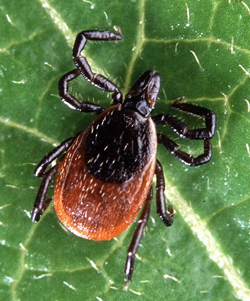
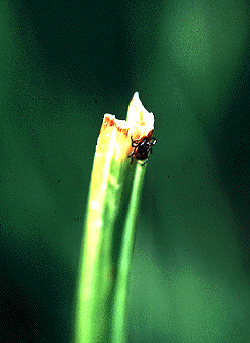
Tick Waiting
Photo Credit: UCA Davis
Ticks live and propagate on a diet of blood that they obtain from mammals, including us humans. In our area, they mostly live on deer and small animals like mice, squirrels and voles. They also cling to whatever dogs and cats pass by them, including your pets.
Ticks wait for host animals from the tips of grasses and brush. When brushed by a moving animal or person, they jump off the vegetation and onto the host. We have also found that they will climb up and drop on you from overhead evergreen trees if there is an opportunity. But their place of choice is in high weedy areas.
Our property is only a couple of hundred yards from where the NJ State Wharton Forest begins. There are often deer around, and then so are ticks.
See chart showing tick life cycle stages below,
Damage They Do
Once on your body, ticks poke a hole in your skin and start sucking blood. They can stay on for several days, but then fall off when they are full. Ticks can cause Lyme disease however the tick must be attached for more than 24 hrs before it can transmit the disease as it takes them that long to burrow in deep enough
.Control of Ticks
If youve been near where there are ticks is important to continually check yourself for ticks, and if you find one has attached itself to you, get it off quickly. When a tick is trying to poke into your skin, you can feel sort of an itch. I check every itch. If I find a tick, I get rid of it quickly, before it can do much damage.
Try to make the property around your home tick unfriendly. You seldom find ticks in short grass. Keep your grass mowed. They can be in shrubs and weeds. Weedwack and clear weeds, brush and vines that are not essential.
If ticks are present on vegetation or brush around your property that can't be cleared, you can spray, or spread insecticides that are designed for ticks. Generally, one or two applications per season will be adequate.
Do not encourage deer to hang around on your property. Don't feed deer. If you have a dog, deer will probably stay away. However, your pets should be checked daily for ticks just like you check yourself after having been out in the yard. A tick attached to your animal that is NOT removed, will grow larger until it is completely bloated with blood. It will then drop off to go lay eggs.
Precautions
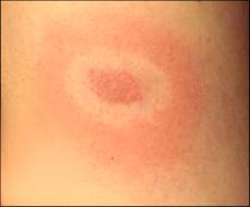
Lyme Disease Bulls-Eye Rash
If you are going into areas which you think might contain ticks, wear clothing that covers your skin the best you can. They can still get on your clothing, and later crawl onto your skin. Check yourself, your children and other family members every couple of hours for ticks. Remove any tick promptly. The best way to remove a tick is to grasp it firmly with tweezers as close to your skin as possible, and just behind the head/neck of the tick, and gently, but firmly, pull it straight out. Sometimes it is quite a tug.
If you experience a rash that looks like a bull's-eye, or a rash anywhere on the body, or an unexplained illness accompanied by fever following a tick bite, you should consult your physician and explain that you were bitten by a tick. Disease carried by ticks can be treated with antibiotics.
Your pets can also get ticks. Animals can bring ticks into the house from outside. They get a free ride on the dog or cat. If you have an animal, periodically check it for ticks. When you pull them off, he or she will be greatful. Then check yourself again.
Lyme Disease
Lyme disease can be transmitted to the human body by the bite of a tick. Early symptoms may include fever, headache, fatigue, depression, and a characteristic circular (Bulls-Eye) skin rash. Left untreated, later symptoms may involve the joints, heart, and central nervous system. In most cases, the infection and its symptoms can be eliminated by antibiotics, especially if the illness is treated early.
A few years ago I had a tick bite that resulted in the characteristic bulls-eye rash. My doctor prescribed the antbiotic Doxycycline. After taking this remedy for a few days the rash disappeared and I didn't suffer any bothersome symptoms.
Babesiosis
Babesiosis is another parasitic illness spread by ticks. Most healthy people do not develop noticeable symptoms of the disease, however some people develop headaches, chills and fever. Though far less common than Lyme disease, Babesiosis can be life threatening, particularly to people with compromised immune systems, and for people without a spleen and the elderly.
Like Lyme disease, Babesiosis can be treated with antibiotics. However, at present, there is no widely used screening test for Babesiosis. In 2011 more than 1000 cases were reported, mostly in the Northeast and upper Midwest.
Tick Life Cycle Stages
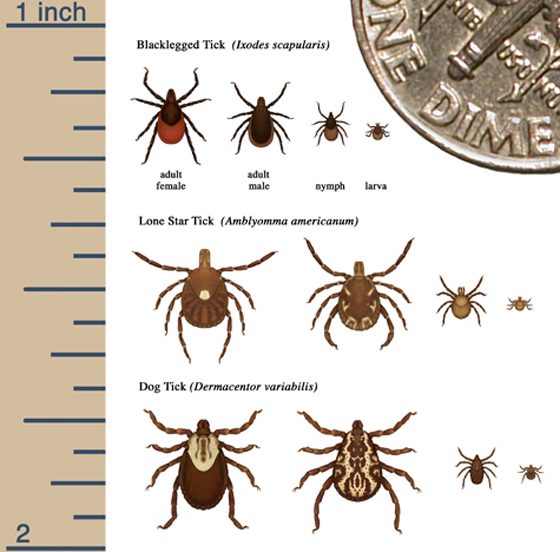
Image Courtesy of CDC
Topical Tick Control
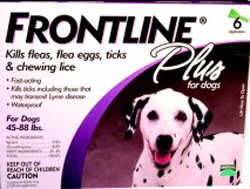
Your own pets can pick up ticks. They can harm the pet and if brought into the home can get on family members and hurt them. Topical tick and flea control products are now available that will protect your pet from both ticks and fleas.
Topical flea and tick control products contain insecticide ingredients that are applied to your pet and will protect it from both fleas and ticks for about a month. You apply these ingredients using an applicator tube. Typically you part some hairs, and find some skin, usually on the back between the shoulder blades, then apply the contents of the applicator tube. The active ingredients spread via body oils to hair follicles and then kill the insects. These products contain two ingredients, one kills adult insects , and the other prevents any laid eggs from hatching.
Topical tick control products recommended by veterinarians include:
Frontline Plus
and K9 Advantix II. A summary of these products is shown in the following table.
| Product | Available For | Insects Killed | Active Ingredients |
|---|---|---|---|
| Frontline Plus | Dogs | Fleas | Fibronil |
| Cats | Ticks | S methoprene | |
| Lice | |||
| K9 Advantix II | Dogs | Fleas | Imidacloprid |
| Ticks | Permethrin | ||
| Mosquitos | Pyriproxyfen | ||
| Lice | |||
| Flies |
Fibronil, Imidacloprid, and Permethrin are insecticides. S methoprene and Pyriproxyfen are growth regulators.
These products are applied once a month and are water resistant. Some of these products come in different stengths, depending on the weight of your pet.
Typically one would buy a six pack that would cover your pet for 6 months and would cost between $40 and $60.
These flea and tick control products are available at Amazon Tick Control

